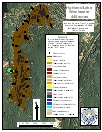Highland Lake, Winchester
2004 Aquatic Plant Survey Map of Highland Lake
Highland Lake is a natural lake that was raised 10 feet with the construction of a dam. Maximum depth is 63 feet, and mean depth is 24 feet. The shoreline is extensively developed with houses, and the only forested area that remains is part of Burr Pond State Park, on the west side of the lake’s southern end.
The 445-acre Highland Lake has a rich community of aquatic plants. A total of 16 species were recorded during a 2004 survey. Of these, three were invasive species, including both Eurasian watermilfoil (Myriophyllum spicatum) and variable-leaf watermilfoil (Myriophyllum heterophyllum). The third invasive species is minor naiad (Najas minor). Eurasian watermilfoil has become a concern for lake residents, and an herbicide was applied in 2004 to reduce its abundance. Historically, the lake water level had been reduced during the winter to reduce aquatic plant abundance.
Perhaps in part because of the June pesticide treatment, the most abundant aquatic plant observed during a September survey in 2004 was eelgrass (Vallisneria americana). The species was particularly abundant in shallow coves, where it occurred with small patches of clasping-leaf pondweed (Potamogeton perfoliatus), variable pondweed (Potamogeton gramineus), and bur-reed (Sparganium species). Large areas of the lake bottom were covered by charaphyte algae (Chara) all around the lake.
Highland Lake is composed of three basins. A state boat launch exists at the lake’s northern basin. Patches of eelgrass and slender naiad (Najas flexilis) were found in the northern basin. Most of these plants were confined to water less than six feet deep. Some plants of Eurasian watermilfoil and variable-leaf watermilfoil were found in deeper water – up to 14 feet deep.
The middle basin of the lake supported patches of eelgrass and slender naiad along both the western and eastern shores, with one moderately large patch of Eurasian watermilfoil recorded on the east side and patches of large-leaf pondweed (Potamogeton amplifolius) on the east side, just north of the narrow connection to the southern basin.
The lake’s southern, and largest, basin supported patches of eelgrass and charaphyte, but few other species were found outside of one cove on the west side, where many species of submerged plants were abundant. In this cove, clasping-leaf pondweed, slender naiad, the invasive minor naiad, coontail (Ceratophyllum demersum), common bladderwort (Utricularia macrorhiza), and both milfoil species all occurred with eelgrass and the floating-leaved species yellow water lily (Nuphar variegata).
| Species recorded in our 2004 survey of Highland Lake. Scientific Names *Invasive Species |
|||
| Bur-Reed | Eelgrass | Longstem waterwort | Spiney-Spored quillwort |
| Clasping-Leaf pondweed | Eurasian watermilfoil* | Minor naiad* | Variable pondweed |
| Common bladderwort | Humped bladderwort | Small pondweed | Variable-Leaf watermilfoil* |
| Coontail | Large-Leaf pondweed | Southern naiad | Yellow water lily |


